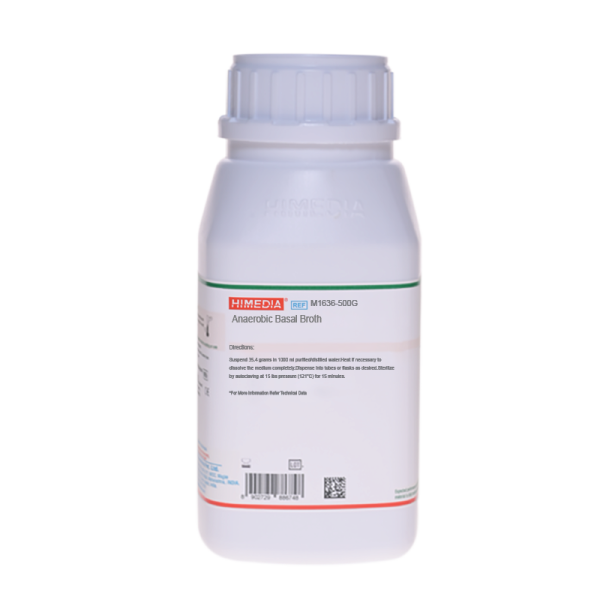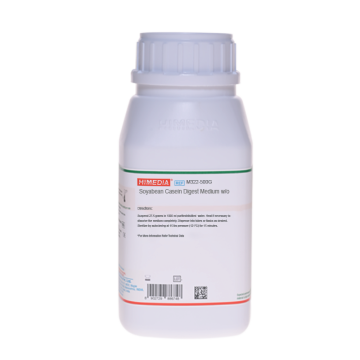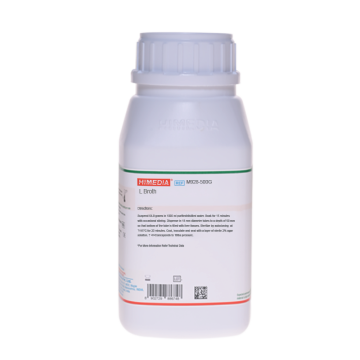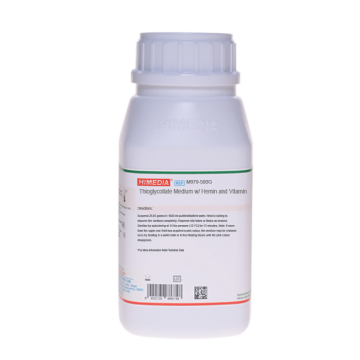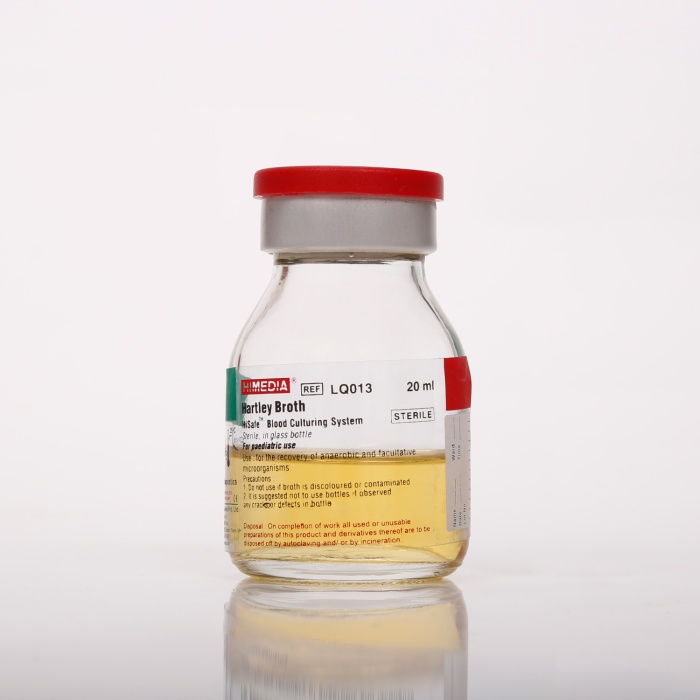 Your enquiry has been submitted
Your enquiry has been submitted
Anaerobic Basal Broth
Intended Use
Recommended for the growth of anaerobic microorganisms, particularly Bacteroides species and other fastidious anaerobes.
Composition**
| Ingredients | g / L |
|---|---|
| Peptone | 16.000 |
| Yeast extract | 7.000 |
| Sodium chloride | 5.000 |
| Starch | 1.000 |
| Dextrose (Glucose) | 1.000 |
| Sodium pyruvate | 1.000 |
| Arginine | 1.000 |
| Sodium succinate | 0.500 |
| Sodium bicarbonate | 0.400 |
| L-Cysteine hydrochloride | 0.500 |
| Ferric pyrophosphate | 0.500 |
| Hemin | 0.005 |
| Vitamin K | 0.0005 |
| DL Dithiothreitol (DTT) | 1.000 |
| Sodium thioglycollate | 0.500 |
Final pH ( at 25°C): 6.8±0.2
**Formula adjusted, standardized to suit performance parameters
Directions
Suspend 35.4 grams in 1000 ml purified/distilled water. Heat if necessary to dissolve the medium completely. Dispense into tubes or flasks as desired. Sterilize by autoclaving at 15 lbs pressure (121°C) for 15 minutes.
Principle And Interpretation
Bacteroides are major bacteria found in the human normal flora, harboring in the intestinal tract. They are generally opportunistic anaerobes and can cause a variety of infections throughout the body. The most common infections include pleuropulmonary, intraabdominal and infections of the female urogenital tract. Bacteroides make up about one-third of the total anaerobic isolates obtained from various infections. Anaerobic Basal broth is recommended for fastidious anaerobes like Bacteroides species. Anaerobic organisms require reducing conditions and an absence of dissolved oxygen in the medium. Strict anaerobes obtain its energy and intermediates through oxidation utilizing hydrogen acceptors other than oxygen. Pre-reducing the medium by boiling to drive off the oxygen can expel this. Also reducing agents such as thioglycollate or cysteine can be added to the medium (1).
Anaerobic Basal broth contains peptone and yeast extract which provides nitrogen and carbon source, long chain amino acids and necessary vitamins for growth of Bacteroides. Starch absorbs toxic metabolites produced (2). Sufficient arginine is added to ensure the growth of Eubacterium lentum (3). Hemin and Vitamin K serves as growth factors for many Bacteroides species (4). Sodium succinate improves the growth of Prevotella melaninogenica and Bacteroides species (5). Sodium pyruvate is the energy source and also acts similarly to catalase and degrades traces of hydrogen peroxide, which may be produced by the action of molecular oxygen on media components (6). L-cysteine hydrochloride and dithiothreitol act as reducing agents (7).
Type of specimen
Clinical samples - Throat, sputum, faeces, rectal swabs, skin and adjacent mucous.
Specimen Collection and Handling
For clinical samples follow appropriate techniques for handling specimens as per established guidelines (8,9). After use, contaminated materials must be sterilized by autoclaving before discarding.
Warning and Precautions
In Vitro diagnostic use only. For professional use only. Read the label before opening the container. Wear protective gloves protective clothing/eye protection/ face protection. Follow good microbiological lab practices while handling specimens and culture. Standard precautions as per established guidelines should be followed while handling clinical specimens. Safety guidelines may be referred in individual safety data sheets.
Limitations
- Further recovery from this enriched broth onto selective media (M1635) is required.
- Biochemical characterization is carried out from pure isolates for complete identification.
Performance and Evaluation
Performance of the medium is expected when used as per the direction on the label within the expiry period when stored at recommended temperature.
Quality Control
Appearance: Cream to yellow homogeneous free flowing powder
Colour and Clarity of prepared medium: Light amber coloured clear to slightly opalescent solution
Reaction: Reaction of 3.54% w/v aqueous solution at 25°C. pH : 6.8±0.2
Cultural Response: Cultural characteristics observed with added 5% w/v sterile defibrinated blood, after an incubation at 35-37°C for 18-48 hours.
| Organism | Inoculum (CFU) | Growth |
|---|---|---|
| Peptostreptococcus anaerobius ATCC 27337 | 50-100 | luxuriant |
| Prevotella loescheii ATCC 15930 | 50-100 | luxuriant |
| Clostridium perfringens ATCC 13124 (00007*) | 50-100 | luxuriant |
Key : (*) Corresponding WDCM numbers.
Storage and Shelf Life
Store between 10-30°C in a tightly closed container and the prepared medium at 2-8°C. Use before expiry date on the label. On opening, product should be properly stored dry, after tightly capping the bottle in order to prevent lump formation due to the hygroscopic nature of the product. Improper storage of the product may lead to lump formation. Store in dry ventilated area protected from extremes of temperature and sources of ignition. Seal the container tightly after use. Product performance is best if used within stated expiry period.
Disposal
User must ensure safe disposal by autoclaving and/or incineration of used or unusable preparations of this product. Follow established laboratory procedures in disposing of infectious materials and material that comes into contact with clinical sample must be decontaminated and disposed of in accordance with current laboratory techniques (8,9).
Reference
- Collee J. G., Fraser A. G. , Marmimon B. P., Simmons A., (Eds.), 1996, Mackie and McCartney , Practical Medical Microbiology, 14th Ed.,Churchill Livingstone.
- Ajello G.W. Geely JC, Hayes PS et al. J. Clin. Micro. 1984:20:55-8.
- Sperry JF. Wilkins TD. J. Bacteriol. 1976:127:780-784.
- Gibbons RJ and MacDonnald JB. J. Bact, 1960:80:164-170.
- Lev M. Keudell KC and Milford AF. J. bact, 1971:108:175-8.
- Neilson PA. J. Clin. Micr, 1983:17:276-279.
- Shanson DC and Singh J. J. Clin. Path. 1981:34:221-3.
- Isenberg, H.D. Clinical Microbiology Procedures Handbook 2nd Edition.
- Jorgensen, J.H., Pfaller, M.A., Carroll, K.C., Funke, G., Landry, M.L., Richter, S.S and Warnock., D.W. (2015) Manual of Clinical Microbiology, 11th Edition. Vol. 1.
| Product Name | Anaerobic Basal Broth |
|---|---|
| SKU | M1636 |
| Product Type | Regular |
| Physical Form | Powder |
| Origin | Animal |
| Packaging type | HDPE |
| References | 1. Collee J. G., Fraser A. G. , Marmimon B. P., Simmons A., (Eds.), 1996, Mackie and McCartney , Practical MedicalMicrobiology, 14th Ed.,Churchill Livingstone. |
| Customized Product Available | No |



